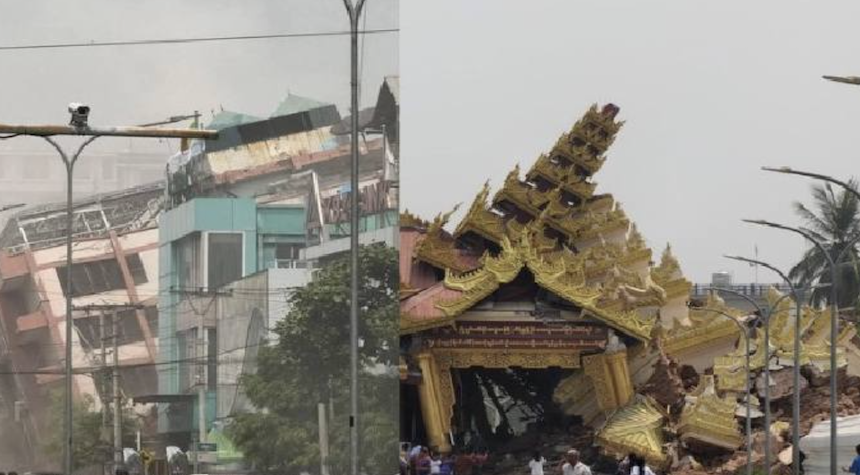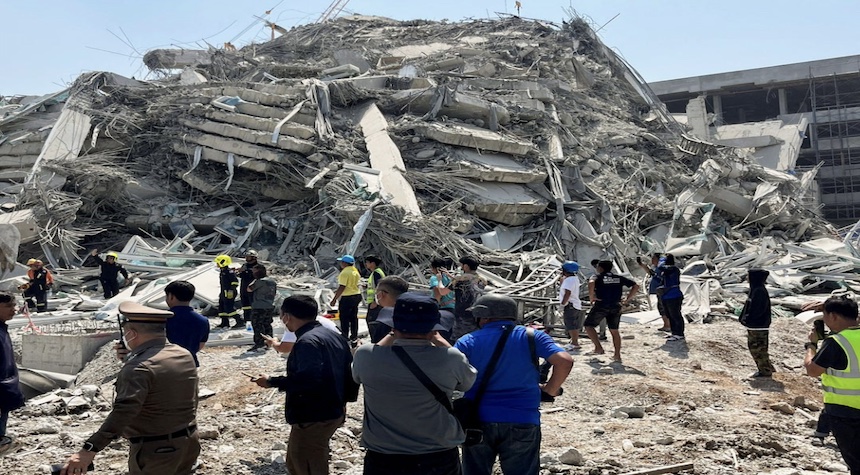The 7.7-magnitude earthquake that struck Thailand and Myanmar at midday Friday killed three people in Bangkok and buried dozens of others when a building under construction collapsed and caused a state of emergency to be declared by Myanmar.
A strong aftershock of 6.4 magnitude followed the midday temblor near Mandalay, Myanmar’s second-largest city.
Myanmar’s military government declared an emergency in six states and regions, including Naypyitaw. But with the country in a bloody civil conflict it wasn’t clear how much help would reach many areas.
Red Cross officials said that downed powerlines are a major obstacle for their teams as they try to reach Mandalay, Sagaing, and the southern Shan State.
The Red Cross reported that “initial reports on the ground indicate the earthquake caused significant damage.” Information on humanitarian needs is being collected.
Rescue worker Songwut Wangpon informed reporters that in Bangkok, a construction worker was killed by falling rubble and debris from the collapsed building site. Another was also crushed, according to Songwut Wangpon.
Defense Minister PhumthamWechayachai stated that three people died at the scene and 90 remain missing. He did not provide any further details on the ongoing rescue operations, but the first responders reported that seven people had been rescued from the outside of the collapsed building.
Rescue workers claim that the rubble remains too unstable to search for people trapped underneath.
On social media, a video showing the collapse of a multi-story building near Bangkok’s Chatuchak market was circulated. The building had a crane at the top and fell into a dust cloud as onlookers ran away screaming.

People in Bangkok who evacuated their buildings were warned to remain outside in case of more aftershocks.
According to preliminary reports, the U.S. Geological Survey (USGS) and Germany’s GFZ centre for geosciences reported that the earthquake occurred at a depth of 10 kilometers (6 miles).
Sirens were heard throughout Bangkok’s central area, and cars filled the streets. Some of the already congested roads became gridlocked. The elevated rapid transit and subway systems were closed.
The city hall declared the area a disaster zone to facilitate emergency aid and interagency assistance. More than 17 million people live in the greater Bangkok region, including many who live in high-rise apartment buildings.
April Kanichawanakul, who works in a Bangkok city centre office building, initially didn’t realize that it was an earthquake. It was the first time she had ever experienced. She said, “I thought I was dizzy.”
She and her colleagues ran down from the 10th floor of Tonson Tower and waited for a signal to let them go back inside.
“All of a sudden, the entire building started to move.” Fraser Morton was a Scottish tourist who was shopping in Bangkok for camera gear.
“I started walking calmly first, but then the building started moving. Yeah, a lot was screaming, a bunch of panic, people running down the escalators the wrong way, and lots of banging, breaking, and crashing in the mall.”
As Morton did, thousands of people from the nearby high-rises, shopping malls, and apartment blocks along Bangkok’s busy Sukhumvit Road poured into Benjasiri Park.
Others sought shelter from the early afternoon heat. Some stared in fear at the tall, densely packed buildings.
Morton: “It was pretty intense when I got outside and looked up and saw the building moving. Dust and debris were everywhere.” “Lots and lots of chaos.”
Voranoot Triawat, an attorney in central Bangkok, said that her first clue to something being wrong was when she noticed a light moving back and forth. She then heard the building swaying back and forth as a result of the shockwaves.
She and her friends ran down 12 flights. She said, “I can’t remember a Bangkok earthquake of this magnitude in my lifetime.”
Paul Vincent, an English tourist, was in a bar on a street when the earthquake struck.
He said, “The next thing was that everyone came out on the streets, and there was a great deal of panicking and screaming, which made it worse.”
He said that as he walked down the street, he noticed a high-rise building swaying. Water was also falling from a roof pool.
He said, “It hit me when I saw the building. Oh my God.” “People were crying on the street, and the panic was horrendous.”

According to photos and videos posted on Facebook, an earthquake in Mandalay, Myanmar’s second largest city and near the epicenter of the quake, damaged a part of the former palace and other buildings.
The area is not densely populated, and the majority of houses are low-rise.
A 90-year-old bridge in the Sagaing area, just southwest of Mandalay, collapsed. Some sections of the highway linking Mandalay with Myanmar’s biggest city, Yango,n were also damaged.
When the earthquake struck, residents in Yangon fled their homes. No immediate reports of injury or death were made.
The quake in Naypyitaw’s capital damaged some homes and religious shrines.
According to Chinese media, the earthquake in the northeast was felt by Yunnan, Sichuan, and Yunnan Provinces of China. It caused injuries and damage to homes in Ruili, a city on the border between Myanmar and China.
One outlet reported that it received videos from someone in Ruili showing building debris on a street and a man being wheeled into an ambulance in a stretcher.
One resident of The Paper, a media outlet online, said that the shaking in Mangshi was so intense that people could not stand.
The Paper reported that a resident of Kunming in Yunnan’s provincial capital, Kunming, said her ceiling lamp was shaking violently and swaying. The shaking lasted for more than 10 seconds.
The Department of Disaster Prevention in Thailand said that the earthquake was felt across the entire country.
Prime Minister Paetongtarn Shinawatra convened an emergency meeting to evaluate the impact of this quake.

